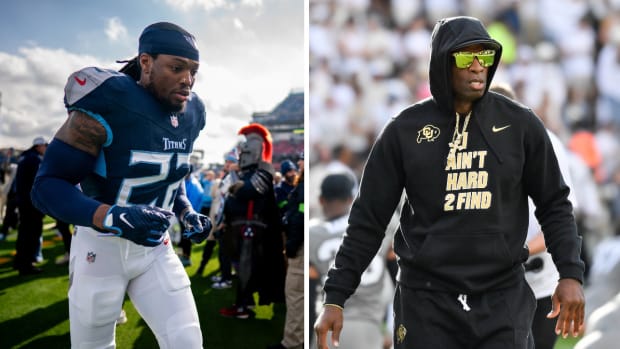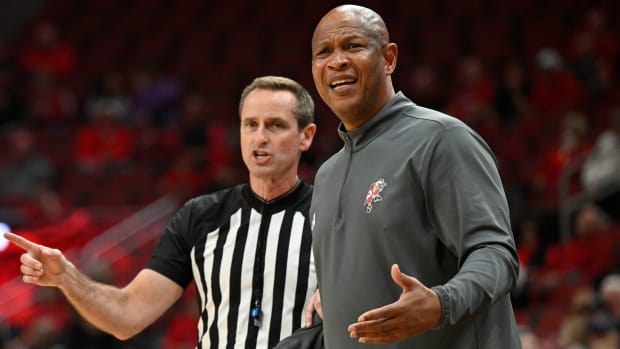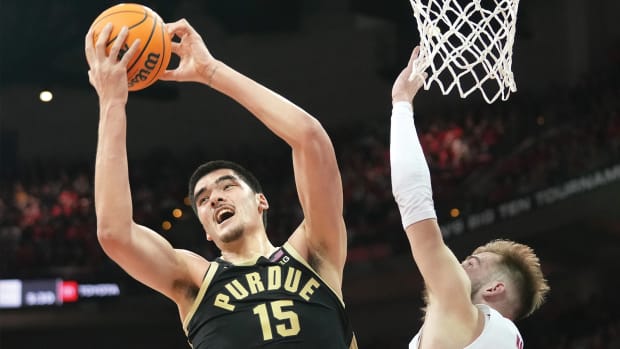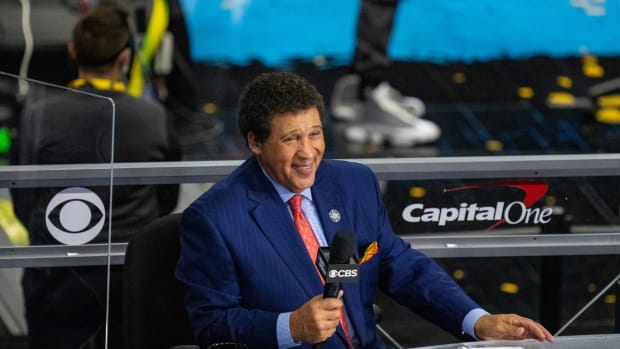Explosive Weekend Raises Doubts About Whether the NCAA Can (and Should) Survive
The NCAA has been vigorously criticized from the outside forever. It’s a fat, slow-moving target, easily harpooned by those who find college athletics to be poorly governed at best and immoral at worst. If you have no stake in the NCAA, you probably hate the NCAA.
But now the threats are internal, too. The calls are coming from inside the house.
From the players to the conference power brokers, people who are part of the NCAA structure are assaulting the controlling interests of college athletics like never before. On a dizzying weekend, three major stories broke that illustrate existential threats to the NCAA as we know it.
The Washington Post obtained leaked audio from a Southeastern Conference Zoom call last week that included football players voicing concerns about their own safety regarding playing amid COVID-19 in a discussion with league medical experts. Good for the SEC for having the Zoom call for the players; bad for the SEC for reacting poorly to it being leaked.
Then hundreds of Pac-12 football players announced a proposed boycott, delivered a list of demands to conference and university leadership, and voiced their unified determination to Sports Illustrated and other media outlets. In a summer of unprecedented player power, this is the biggest flex yet.
Also Saturday, SI reported that leaders from Power 5 conferences have initiated discussions about staging their own breakaway fall championships if the NCAA Board of Governors postpones or cancels them. While most of the conversation has been at the athletic director level thus far, at least one P5 commissioner is personally involved in weighing logistics of the concept. Sources told SI Sunday that a tentative plan calls for each P5 conference to host one fall championship: men’s and women’s soccer hosted by one league; men’s and women’s cross country by a second; volleyball by a third; field hockey by a fourth; and men’s water polo by a fifth.
For decades, people have theorized and even fantasized about the Power 5 (the Atlantic Coast Conference, the Big 12, the Big Ten, the Pacific-12 and the Southeastern) breaking off and leaving the rest of Division I behind. This is a sign of increased intent to consider a secession of sorts.
Taken individually, each story is startling news. Taken collectively, it is a flurry of body blows that signal a critical inflection point for college sports. Is a controversial collegiate system buckling beneath its own weight? Can eternally embattled NCAA president Mark Emmert survive this? Should either Emmert or the institution itself survive?
“It’s probably the toughest period the NCAA has faced in a long time,” a veteran Power 5 athletic director told Sports Illustrated Sunday. “I can’t look at an issue in recent times and say, ‘We got good leadership on that.’ It’s hard not to see significant change coming out of this.”
Will that change include replacing Emmert, whose decade-long tenure has played out to a near-constant drumbeat of criticism?
“Probably not,” said the same athletic director, noting that small colleges with far less interest in athletics than the Division I powers could block an attempt to oust Emmert, who has better support on the presidential level, particularly in Divisions II and III. “Is there anything that speaks more to the limitations of the NCAA than the fact that Mark will probably survive?”
This would be the definition of dysfunction: the wildly unpopular leader of a billion-dollar entity whose job is saved by schools that college sports fans pay no attention to.
The landslide opinion within the industry is that the NCAA has provided precious little leadership during the COVID-19 pandemic. Its lack of national authority has been laid bare, as conferences have wound up making their own uncertain paths through the spring and summer and laid plans for the fall. The disconnect was never more apparent than two weeks ago, when the NCAA Board of Governors was prepared to cancel or postpone all fall sports before an 11th-hour request from DI administrators resulted in delaying that vote.
(Said vote could happen Tuesday, when the Board of Governors meets again. The expectation is that the board will cancel/postpone at the Division II and III levels while holding off on a decision on DI. That delay won’t be well received on DI campuses that want both clarity for their athletes and a path toward playing.)
Then there are the bills coming due after decades of resistance to compensating student-athletes, which has resulted in the NCAA asking Congress to intervene and solve the problem. That chronic, underlying financial inequality is the largest driver of the player protest movement, although the movement has gained added resonance due to racial and health concerns.
For the longest time, the NCAA and all its power brokers could count on the traditionally compliant athletes to shut up and play. Now they’ve joined the chorus of critics — but with more clout. If they don’t play, there are no games.
Coming off one turbulent week in college athletics and now lurching into another, the big questions are both short term and long:
- Short term: will the show go on this fall, and if so will the players play? The list of demands from the Pac-12 was understandably ambitious and also a bit unrealistic, given our current reality. They swung big. We’ll see how much contact they ultimately made, and whether this movement spreads to other conferences.
Understand that most of them very much want to play, but they also might gauge a limited and potentially disappointing season as the right time to make a stand. A hill that some might not have been willing to die on in previous years might be the right place at the right time now. If the Pac-12 and other leagues don’t treat this power play with respect and compassion (not the same thing as capitulation, of course), it would be yet another error by the rich adults in charge.
- Long term: is this the beginning of the end of the NCAA as we know it? It could be, but the ramifications would be massive and the new structure might be every bit as bad as the current structure.
For years, the Power 5 has tolerated the NCAA for two big reasons: it organized, hosted and paid for national championships (well) and enforced the rulebook (not so well). Now, the championship part is subject to revocation. The compliance part is the harder part, because the feuding five conferences would seem as unlikely as rival organized crime syndicates at coming up with a way to police each other.
“Just as they couldn’t consolidate over the fall schedule, so I think they’d have difficulty forming an entirely new entity,” an AD said Sunday.
A new, Power 5 version of the NCAA would almost certainly feature a lot of the same old faces in college athletics, and most of those would be in favor of the same old structure: fistfuls of cash for the schools; resistance to sharing it with the players. It might kill off some of the layers of bureaucracy, but it might also kill off the NCAA basketball tournament along the way.
How much fun would March Madness be if it were simply 40(ish) Power Five programs playing each other? Where is the charm in an event that includes zero small schools or mid-major overachievers? A Big Dance with no Cinderella — no Loyola Chicago, no George Mason, no VCU? A tournament without a basketball-centric power from outside the football oligarch — no Gonzaga, no Butler, no Connecticut, no Memphis?
It would stink.
So be careful what you wish for if you’re embracing a break from the NCAA. Change is overdue, change is needed, and change is on the way. But some solutions might be worse than the old problems we've been dealing with for years.




